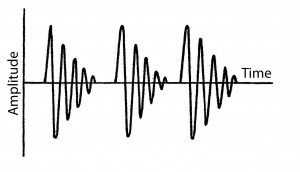It only ran for a short time and didn't hurt anyone, and gave us at least a feel of what it was like to hear an old spark signal.
I've been fascinated by the concept behind damped-wave "spark" transmitters (v.s CW) and how they use a spark discharge to trigger a much higher RF oscillation:

By using a disc with several "points" on it rotated at high speed, the spark discharge frequency could be increased within the audible range of several hundred Hz. This effectively created a damped wave modulated by a tone which could be heard more easily than the much grungier sound of a lower rate spark discharge.
W2PA offers an excellent summary on his website:
http://w2pa.net/HRH/spark-radio/These stations sent Morse Code. "CW" was sent by stations that used oscillating vacuum tubes that created a Continuous Wave (vs the damped wave of the spark transmitters). The CW stations were much more spectrum efficient although they required a BFO oscillator to be added to receivers. Ops had to switch their receiver modes between Spark and CW!



